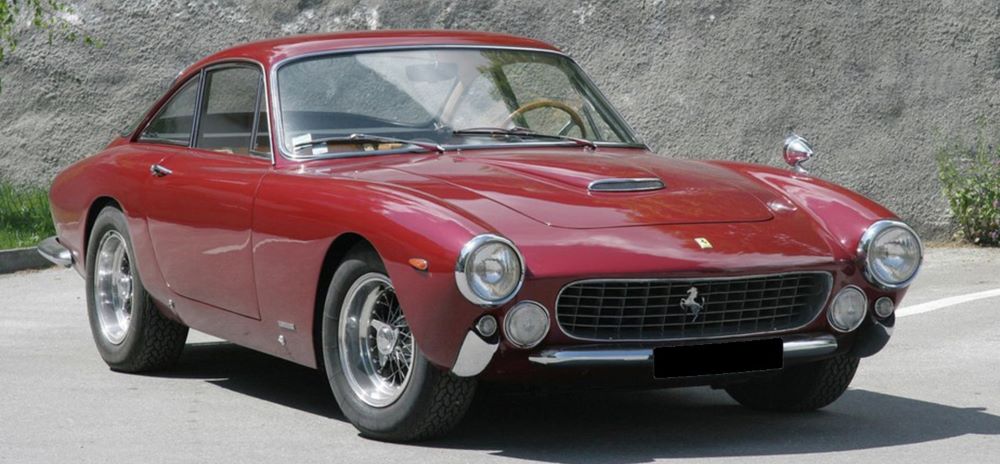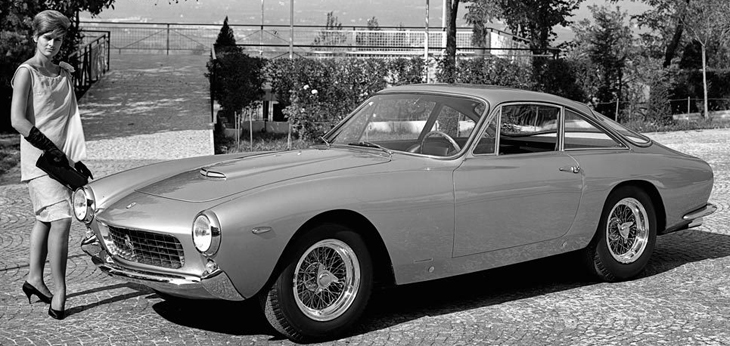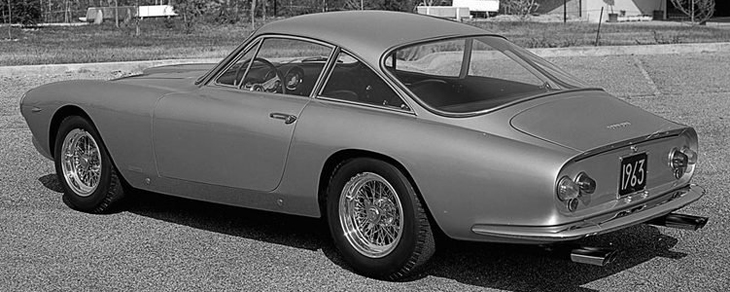
The 250 GT Berlinetta Lusso, which made its debut at the 1962 Paris Salon, was the final model in the 250 GT series in pure road car form and continued in production until the latter part of 1964, by which time 350 cars had been produced. It was the direct replacement for the 250 GT Coupé, as although there was a ‘Lusso’ street version of the 250 GT ‘passo corto’ Berlinetta, this didn’t have an excess of interior or luggage space.
The body styling from Pininfarina (production cars were built by Scaglietti in Modena) won immediate praise, and featured a front-end design with a wide and low egg crate grille similar to the 250 GT ‘SWB’ Berlinetta. It had a three-piece bumper arrangement, with a horizontal bar below the grille and a small vertical bumperette cradling the side/turn light on each front wing, with inbuilt circular driving lights between them and the grille. The front wing line curved over the wheel arches to fall gently through the door panel, with the rear wing line running from the door shut line, skirting the base of the rear quarter glass, before falling in a long curve into the Kamm tail panel, which had a shallow aerodynamic lip to its upper edge.
The prototype of the series, chassis 3849GT, shown at the Paris Salon and also featured in the sales catalogue, had a small central vertical bar to the grille on the hood intake, 250 GT 2+2 style door handles, no driving lights in the front panel, and separate circular reflectors, rear and turn lights in the tail panel. The production cars had a plain mesh to the hood intake, with a large circular combination rear/turn/reflector light unit on each side of the recessed tail panel. This light design was also used on the succeeding 275 GTB series of berlinettas. A wrap-around chrome-plated bumper was fitted below the recessed tail panel, which had a pair of registration plate illumination lights on its lower edge. The cabin was a five window design with very slim roof pillars, and the large curved rear screen was at a shallow angle flowing into the boot line. The whole shape was a statement of sweeping elegance, with a hint of aggression from the competition model-derived radiator grille.
The bodies were constructed from steel with aluminium opening panels (doors etc.), and mounted on a 2400 mm wheel base tubular steel chassis with factory reference number 539/U. All were numbered in the odd chassis number road car sequence carrying a ‘GT’ suffix. The chassis construction was similar to that of the concurrent 250 GT ‘passo corto’ berlinettas: two large, oval section longitudinal members with cross bracing, but with the engine mounted further forward in the frame to increase cabin space. Like their stable mates, they were available as right- or left-hand drive. Similarly, the mechanical components such as suspension, brakes and steering were to a design analogous to that model.
The engine was a derivation of the single overhead camshaft, per bank 3-litre V12 Colombo-designed ‘short’ block unit, with factory type reference 168/U. It had an outside the vee spark plug design, of 2953 cc capacity, with a bore and stroke of 73 x 58.8 mm. Fitted with a bank of three twin-choke Weber 36 DCS carburettors, with a twin coil and rear-of-engine mounted distributor ignition system, it was claimed to produce 240 bhp. The engine was coupled with a 4-speed + reverse all-synchromesh gearbox, with final drive through a propeller shaft to the rigid rear axle, for which two alternative ratios were available.
The interior was leather trimmed with a pair of deep bucket seats, behind which was a luggage platform with leather straps and a diamond quilted cover panel to the top of the parcel shelf. The instrument layout was unusual in that the two main dials –speedometer and rev counter – were housed in a pair of large circular binnacles that protruded from the top centre of the dashboard, and were angled towards the driver, with the supplementary gauges in a horizontal panel directly in front of the steering wheel.

In 1963 a 250 GTO, chassis 4713GT, was constructed with an all-aluminium body based on the 250 GT Lusso styling, albeit with a GTO-style nose section and a pronounced rear spoiler. Four 330 LM Berlinettas were also built in a similar form during the same year. Battista Pininfarina had a special version built for himself on chassis 4335GT. This initially featured only subtle differences: the rectangular lever door handles, the omission of the quarter light on the driver’s door and the driving lights in the front panel, a tapering hood bulge without an intake, plus a more pronounced lip to the Kamm tail. In the middle of 1963 it was provided with a modified front end which had echoes of the 250 GTO nose shape, although the ellipse was deeper and wider, like that of the 400 SA model, bounded by chrome-plated quarter bumpers with vertical over-riders. The headlights were recessed in the wings with Plexiglass covers and small, flush-mounted horizontal oval side/turn lights were provided between the headlights and quarter bumpers. The dash layout on this car was more conventional, with the main instrument pods for the speedometer and rev counter mounted directly in front of the driver, as they had been on the Paris Salon prototype. A further example, chassis 4385GT, was provided with special features at the request of the client, who had originally wanted a 250 GTO. The changes included a GTO-style nose section incorporating covered headlights, a six carburettor set-up with open intake trumpets, and high lift camshafts.
Although the 250 GT Lusso was designed and built as a high-performance road car, some owners took them into competition. The model made appearances in the Targa Florio in 1964 (finishing thirteenth overall) and 1965, and another achieved the same result in the Tour de France in the same year.

Just 22 right hand drive cars were built. First appearing at the 1962 Paris Salon
Engine
- Type front, longitudinal 60° V12
- Bore/stroke 73 x 58.8 mm
- Unitary displacement 246.10 cc
- Total displacement 2953.21 cc
- Compression ratio 9.2 : 1
- Maximum power 176 kW (240 hp) at 7500 rpm
- Power per litre 81 hp/l
- Valve actuation single overhead camshaft per bank, two valves per cylinder
- Fuel feed three Weber 36 DCS carburettors
- Ignition single spark plug per cylinder, two coils
- Lubrication wet sump
- Clutch single-plate
Chassis
- Frame tubular steel
- Front suspension independent, unequal-length wishbones, coil springs, telescopic shock absorbers
- Rear suspension live axle, radius arms, semi-elliptic springs, co-axial coil springs and telescopic shock absorbers
- Brakes discs
- Transmission 4-speed + reverse
- Steering worm and sector
- Fuel tank capacity 114 litres
- Front tyres 185 x 15
- Rear tyres 185 x 15
Bodywork
- Type two-seater berlinetta
- Wheelbase 2400 mm
- Front track 1395 mm
- Rear track 1387 mm
- Weight 1020 kg (dry)
Performance
- Top speed 240 km/h






You must be logged in to post a comment.